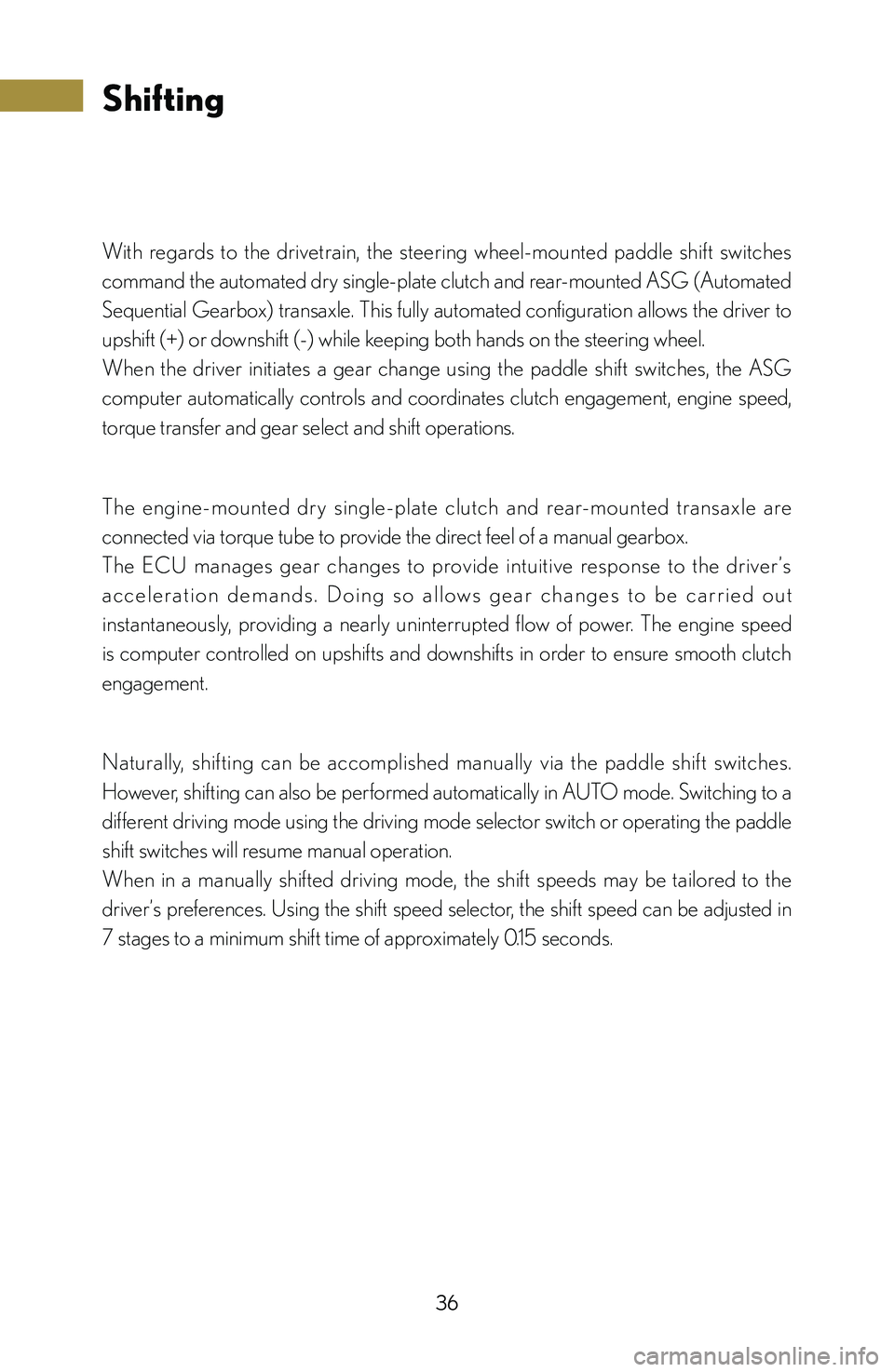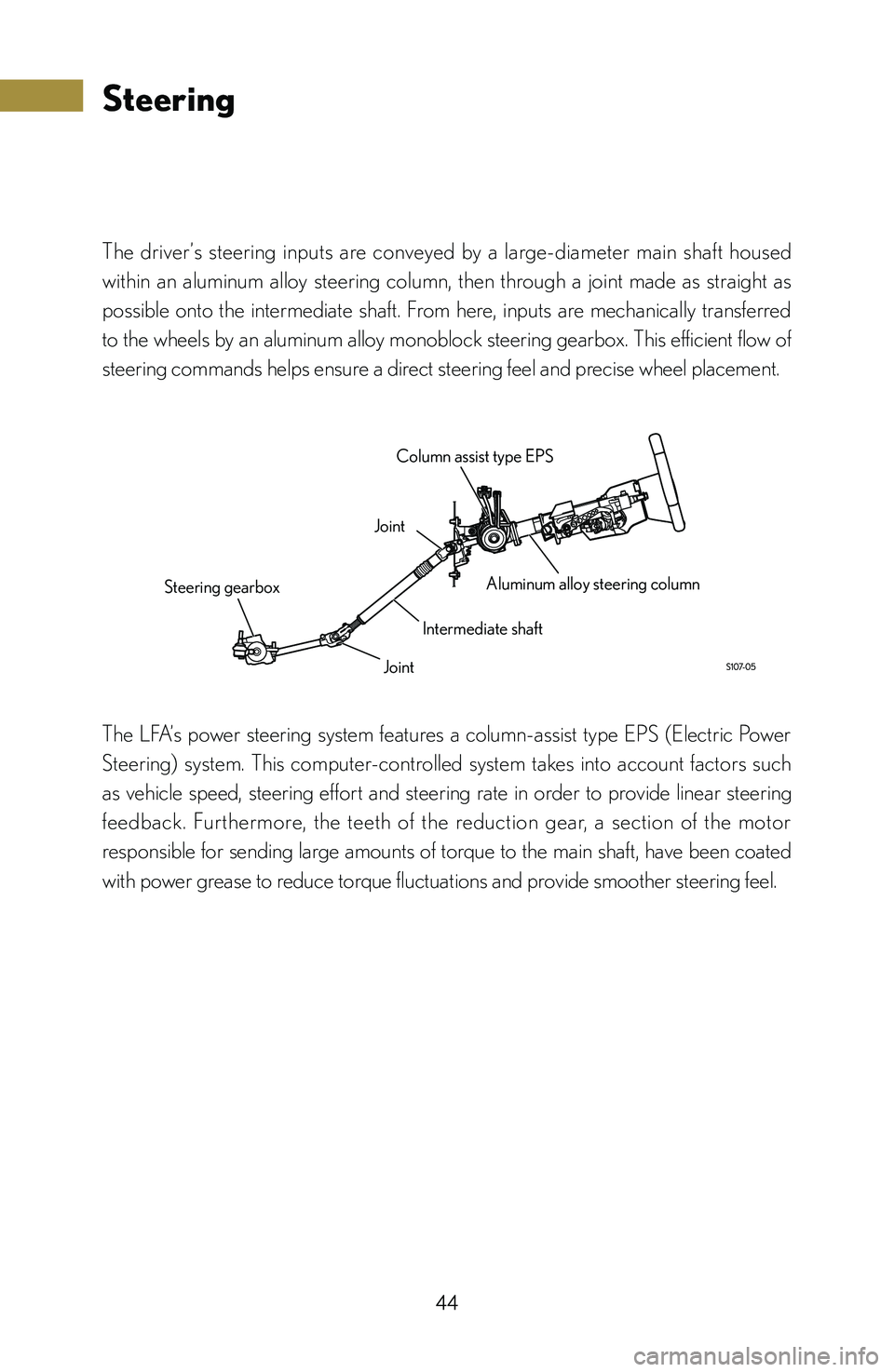Page 38 of 128

36
Shifting
With regards to the drivetrain, the steering wheel-mounted paddle shift switches
command the automated dry single-plate clutch and rear-mounted ASG (Automated
Sequential Gearbox) transaxle. This fully automated configuration allows the driver to
upshift (+) or downshift (-) while keeping both hands on the steering wheel.
When the driver initiates a gear change using the paddle shift switches, the ASG
computer automatically controls and coordinates clutch engagement, engine speed,
torque transfer and gear select and shift operations.
The engine-mounted dr y single-plate clutch and rear-mounted transaxle are
connected via torque tube to provide the direct feel of a manual gearbox.
The ECU manages gear changes to provide intuitive response to the driver ’s
a c c e l e r a t i o n d e m a n d s . D o i n g s o a l l o w s g e a r c h a n g e s t o b e c a r r i e d o u t
instantaneously, providing a nearly uninterrupted flow of power. The engine speed
is computer controlled on upshifts and downshifts in order to ensure smooth clutch
engagement.
Naturally, shifting can be accomplished manually via the paddle shift switches.
However, shifting can also be performed automatically in AUTO mode. Switching to a
different driving mode using the driving mode selector switch or operating the paddle
shift switches will resume manual operation.
When in a manually shifted driving mode, the shift speeds may be tailored to the
driver’s preferences. Using the shift speed selector, the shift speed can be adjusted in
7 stages to a minimum shift time of approximately 0.15 seconds.
Page 40 of 128
38
■
■Torque tube
Employing a torque tube to unite the front-mounted engine with the rear-mounted
transaxle creates an outstanding level of powertrain rigidity.
This aspect is essential in order to extract the most performance out of a vehicle. A
rigid powertrain reduces parasitic losses that occur from unwanted engine movement
and input from the wheels, allowing a greater amount of power to be sent to the road
and a more direct response.
Torque is transferred by means of an input shaft housed within the torque tube. This
fast-spinning shaft is mounted using rubber insulators with integrated bearings to
ensure quietness.
Torque tube
Rubber dampers with integrated bearings
Input shaft
Front counter gear Input shaft
A front counter gear is employed,
allowing the engine to be placed
closer to the ground. The engine
crankshaf t axis is lower to the
ground than the input shaft axis.
Crankshaft axis
Front counter gear
Page 46 of 128

44
Steering
The driver’s steering inputs are conveyed by a large-diameter main shaft housed
within an aluminum alloy steering column, then through a joint made as straight as
possible onto the intermediate shaft. From here, inputs are mechanically transferred
to the wheels by an aluminum alloy monoblock steering gearbox. This efficient flow of
steering commands helps ensure a direct steering feel and precise wheel placement.
Joint Column assist type EPS
Aluminum alloy steering column
Intermediate shaft
Joint
Steering gearbox
The LFA’s power steering system features a column-assist type EPS (Electric Power
Steering) system. This computer-controlled system takes into account factors such
as vehicle speed, steering effort and steering rate in order to provide linear steering
feedback. Furthermore, the teeth of the reduction gear, a section of the motor
responsible for sending large amounts of torque to the main shaft, have been coated
with power grease to reduce torque fluctuations and provide smoother steering feel.
Page 122 of 128

120
Speed Indicator 67
Speedometer 57, 67
SPORT mode 58
SPORT mode
(control characteristics) 26
SPORT mode (selection) 27
Starting off 11
Starting the engine 9, 1 0
Starting the engine by connecting
an external battery 98
Status 67
Steering 44
Steering adjustment 23
Steering column adjustment 9
Steering column shaft-mounted
EPS (Electric Power Steering)
system 44
Steering rack and gearbox 46
Steering system 44
Steering wheel adjustment 23
Steering wheel adjustment lever 9
Steering wheel adjustment
range 23, 45
Steering wheel position
adjustment 23
Steering wheel shape 45
Steering wheel telescoping range 23
Steering wheel tilt range 23
Stop and go traffic 37
Stopwatch 67 , 72
Suppressing dark current
(parasitic current) 93
Suspension adjustment 47
Suspension geometry 47
Synchronizer rings 39
Synchronizers 39
Synchros 39
TTachometer 59
Telescopic adjustment range 23
Telltale needle 71
Temperature display units
selection 67
TFT LCD panel 56
Throttle body valve opening
angle 33
Throttle response 33, 56
Throttle response adjustment 33
Throttle valve opening angle 33
Tilt and telescopic steering control
lever 9
Tilt range 23
Tilt sensor deactivation 102
Tires (vehicle long-term storage) 92
Tool bag 100
Topping up the oil level 69
Torque tube 38
TORSEN® LSD 39
Tow hook 100
Tow truck selection 100
Towing eyelet 100